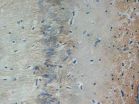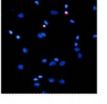(Press-News.org) A recent survey of mountain yellow-legged frogs released into the wild by San Diego Zoo Global wildlife conservationists indicates that the populations are showing signs of stress related to drought conditions in California. The juvenile frogs, released into the San Jacinto mountains in two protected sites, are representatives of a species brought to the brink of extinction by the threat of wildfire, habitat destruction and chytrid fungus. The young frogs hatched at the San Diego Zoo Institute for Conservation Research and were introduced as tadpoles into the wild in 2013.
"When we released these frogs into the wild, we knew they would be facing natural challenges to their survival, like predation," said Frank Santana, a research coordinator with the Institute for Conservation Research. "The drought is adding an additional challenge to their survival, but we are still finding a significant number of frogs that are healthy and growing."
Of the 300 tadpoles that were released, researchers believe about 25% continue to survive. The species is believed to number less than 200 individuals in the San Gabriel, San Bernardino and San Jacinto mountains, where they once thrived. Institute for Conservation Research conservationists, working in collaboration with government partners —U.S. Geological Survey, U.S. Forest Service, U.S. Fish and Wildlife Service, California Department of Fish and Game and University of California — are working to repopulate Southern California with these rare frogs.
Bringing species back from the brink of extinction is the goal of San Diego Zoo Global. As a leader in conservation, the work of San Diego Zoo Global includes onsite wildlife conservation efforts (representing both plants and animals) at the San Diego Zoo, San Diego Zoo Safari Park, and San Diego Zoo Institute for Conservation Research, as well as international field programs on six continents. The important conservation and science work of these entities is made possible by the San Diego Zoo Global Wildlife Conservancy and is supported in part by the Foundation of San Diego Zoo Global.
INFORMATION:
Rare frogs holding their own despite drought conditions
2014-08-11
ELSE PRESS RELEASES FROM THIS DATE:
Astrophysicists detect destruction of 3 stars by black holes
2014-08-11
Researchers from Moscow Institute of Physics and Technology and the Space Research Institute of the Russian Academy of Sciences have reported registering three possible occasions of the total destruction of stars by supermassive black holes at the centers of galaxies.
Details are given in an article by IldarKhabibullin and Sergei Sazonov, accepted for publication by the Monthly Notices of the Royal Astronomical Society journal(a preprint is available at http://www.arXiv.org.
The astrophysicists used data obtained by X-ray orbiting observatories ROSAT and XMM-Newton. ...
'Dimmer switch' drug idea could tackle schizophrenia without side effects
2014-08-11
Discovery of a new mechanism of drug action could lead to the next generation of drugs to treat schizophrenia.
Affecting one per cent of the world's population, schizophrenia is a major health condition. It affects a person's ability to think, feel and act and is associated with distressing symptoms including hallucinations and delusions.
New Monash University findings, published today in the journal, Nature Chemical Biology, offer hope of a new class of drug that can act as a "dimmer switch" to control schizophrenia, without causing some of the common side effects ...
'Worm pill' could ease autoimmune disease symptoms
2014-08-11
Experts believe a molecule in parasitic worms could help explain why worm infections can effectively treat a range of autoimmune diseases, including multiple sclerosis, psoriasis, rheumatoid arthritis and lupus.
The Monash University study, published in the FASEB Journal, successfully identified peptides from parasitic worms that suppress the body's immune response. Researchers believe this could pave the way for a new drug containing the peptide to provide relief from the symptoms of autoimmune diseases.
Affecting as many as one in 20 Australians, autoimmune diseases ...
Autophagy is a new target for treatment of neuronal injury in the hippocampus of VD rats
2014-08-11
Autophagy is a basic catabolic mechanism by which unnecessary or dysfunctional cellular components are degraded by lysosomes. Damaged organelles such as mitochondria are scavenged by autophagic processes to maintain the stability of nerve cells. Excessive activation of autophagy leads to cell death. However, it remains unclear whether autophagy affects hippocampal neuronal injury in vascular dementia. Prof. Bin Liu and co-workers from the Affiliated Hospital of Hebei United University, China intraperitoneally injected wortmannin into a rat model of vascular dementia. They ...
Neuroprotective effects of Asiaticoside
2014-08-11
In the central nervous system, Asiaticoside has been shown to attenuate in vitro neuronal damage caused by exposure to β-amyloid. However, its potential neuroprotective properties in glutamate-induced excitotoxicity have not been fully studied. Researchers from Fourth Military Medical University of Chinese PLA, China reported that pretreatment with Asiaticoside decreased neuronal cell loss in a concentration-dependent manner and restored changes in expression of apoptotic-related proteins Bcl-2 and Bax. Asiaticoside pretreatment also attenuated the upregulation of ...
Selective verbal memory impairment due to left fornical crus injury after IVH
2014-08-11
The fornix, a part of the Papez circuit, transfers information of episodic memory between the medial temporal lobe and the medial diencephalon. It is difficult to precisely assess the fornix due to its long, thin appearance and its location within the brain. In addition, discrimination of the whole fornix from adjacent neural structure using conventional brain CT or MRI is impossible. By contrast, diffusion tensor tractography (DTT) has enabled three-dimensional visualization of the fornix, and many studies have reported on fornix injury using DTT. Dr. Sung Ho Jang and ...
New global research reveals significant shortfall in fruit and vegetable consumption
2014-08-11
New research published in the September issue of the British Journal of Nutrition highlights a significant shortfall in fruit and vegetable consumption in people's diets around the world. Commissioned by the Nutrilite Health Institute of Amway and conducted by Exponent, the research finds the majority of adults worldwide would have to at least double their current consumption of fruits and vegetables to meet the World Health Organization's minimum recommendation of five servings (400 grams) per day. Additionally, the vast majority of adults worldwide – 60 to 87% across ...
Study: new tool proves effective in evaluating doctor's bedside manner
2014-08-11
TORONTO, ON, Aug 11, 2014 —The best way to improve a doctor's bedside manner may lie in a new tool that evaluates and helps medical residents improve their communication and other soft skills to become better doctors, according to a new study led by Women's College Hospital's Dr. Tim Dwyer.
The study, published in the latest issue of the Canadian Journal of Surgery, is the first to look at the medical residents' collaboration, communication and other soft skills, or what are known as CanMEDS competencies, in orthopedic surgical training.
"While we do a great job at ...
Keeping filler ingredients out of your cup of coffee
2014-08-11
SAN FRANCISCO, Aug. 11, 2014 — Coffee drinkers beware: Surprise ingredients that are neither sweet nor flavorful may be hiding in your coffee, and growing coffee shortages may increase the chance of having these fillers in your cup of joe in the future. The good news is that a highly accurate test is in the works to quickly find coffee containing unwanted fillers before the beverage reaches stores and restaurants.
These extra ingredients, though not harmful, make ground coffee go farther and increase profits for producers, according to researchers. Their report will be ...
Solving a sticky problem with fetal surgery using a glue inspired by the sandcastle worm
2014-08-11
SAN FRANCISCO, Aug. 11, 2014 — In creating an adhesive patterned after glue produced by the lowly underwater sandcastle worm, researchers are reporting today that they may have solved the problem of premature births that sometimes result from fetal surgery. It also could open up numerous opportunities to safely perform more complex fetal surgeries in the future. Their report will be presented as part of the 248th National Meeting & Exposition of the American Chemical Society (ACS), the world's largest scientific society.
The meeting, attended by thousands of scientists, ...



